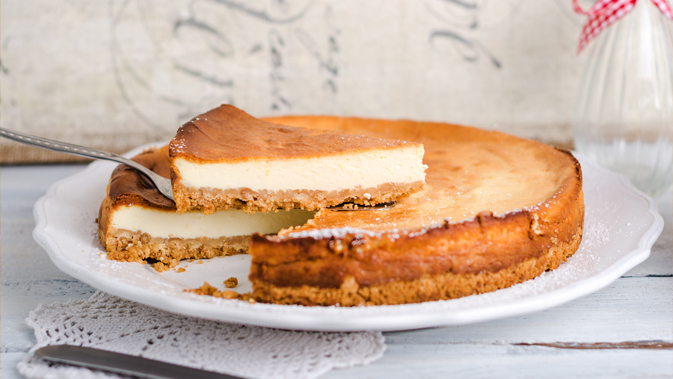Cheesecake: the mouth-watering cake from New York
 Adobe Stock
Adobe Stock
Cheesecake: the mouth-watering cake from New York
It is incredibly creamy and rich and it tastes simply heavenly: the New York cheesecake is a truly classic dish.
The base of this compact cake is made from biscuit crumbs, butter and sugar spread over the bottom of a flan tin. This is covered with a mixture of cream cheese (for example, Philadelphia), eggs and sugar. After you have baked your cheesecake, leave it to cool and then remove it from the springform tin shortly before serving. You can also decorate it with fresh fruit or cover it with a mousse of red berries. Now let’s move on from enjoying the cake to finding out about its history. In 1873, William Lawrence, who lived in Chester in the US state of New York, bought a cheese dairy that made Neufchâtel cheese. He added extra cream to the traditional French cheese and the result was a rich, creamy fresh cheese which he sold under the name cream cheese. In 1880, its name was changed to Philadelphia Cream Cheese.
In New York at that time, people were familiar with the typical German cheesecake. This was a traditional cake that was sold in German Jewish delicatessens and, in the absence of quark, was made with cottage cheese. Later someone had the idea of using cream cheese instead.
There is no reliable information available about who first made the legendary New York cheesecake or which shop it was sold in. Perhaps it was Arnold Reuben, famous throughout the world for his sandwiches, in his deli in Manhattan which opened in 1928. Or perhaps it was Leo “Lindy” Lindemann, born in Berlin, who had been selling Jewish specialities on Broadway since 1921. Whatever the case, many Jewish people took New York cheesecake to their hearts. Milk and dairy products have always been a very important part of Judaism and cheesecake is eaten all year round for dessert or with coffee. It is a tradition. The story that Jewish immigrants from Eastern Europe brought the recipe with them is clearly a myth. But it is a fact that American Jews helped this creamy delicacy to achieve success.
Text: Regine Smith Thyme
New York Cheesecake
INGREDIENTS (makes 12–16 slices)
- 70 g melted butter and a little extra to grease the tin
- 120 g wholemeal biscuits, 40 g nuts (such as walnuts or pecans)
- 25–30 g brown sugar
- 1.225 kg double cream cheese (seven 175 g packs)
- 250 g sour cream or crème fraîche (26–30% fat)
- 1 tsp vanilla paste (from a delicatessen)
- finely grated zest of 1 organic lemon and orange
- 300 g sugar
- 2–3 tbsp lemon juice
- 6 eggs (medium)
- one 24 cm springform tin
- microwave cling film and 1 large sheet of aluminium foil (extra strong)
- one Miele deep-sided oven dish
PREPARATION
- Several hours before starting, take all the ingredients out of the fridge and leave them to reach room temperature.
- Grease the tin with butter. Blitz the biscuits, nuts and brown sugar in a food processor to produce fine crumbs. Pour in the butter and tip the mixture into the tin. Spread it evenly over the base, press it down and then create a slightly raised edge. Firstly, wrap the outside of the tin in microwave cling film, then put it on the sheet of aluminium foil and pull the foil up around the sides of the tin to make sure that it is watertight. Put the tin in the fridge.
- Put the large Miele deep-sided oven dish into the oven on the second shelf from the bottom and preheat the oven to 180°C on the conventional setting. Bring around 1.5 litres of water to the boil.
- Put the cheese in a large bowl and beat it until it is creamy. Stir in the following ingredients one after another: the sour cream and vanilla paste, the lemon and orange zest, the sugar and the lemon juice and finally each unbeaten egg individually. Pour the mixture onto the cake base. Put the cake tin in the Miele deep-sided oven dish, pour the boiling water around it and bake it.
- After 30 minutes, reduce the heat to 140°C. After a further 90 to 100 minutes, turn the oven off and leave the cheesecake to rest in the closed oven for about an hour.
- Take the cheesecake out of the oven, leave it to cool and then put it in the fridge overnight.
Recipe: Marlies Klosterfelde-Wenzel